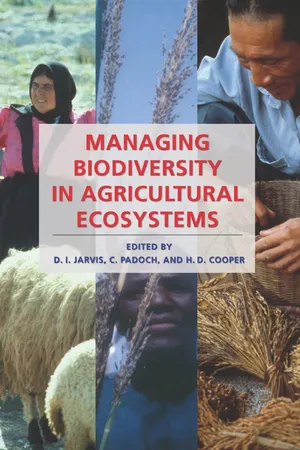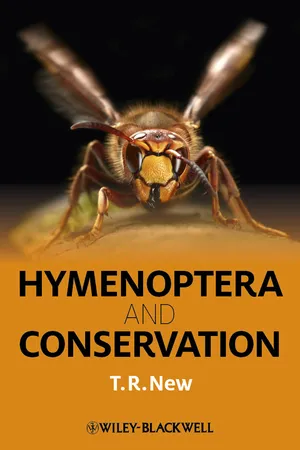Geography
Pollinators
Pollinators are animals or insects that transfer pollen from the male to the female parts of flowers, enabling the plants to reproduce. They play a crucial role in the pollination process, which is essential for the production of fruits, seeds, and new plants. Examples of pollinators include bees, butterflies, birds, and bats.
Written by Perlego with AI-assistance
Related key terms
3 Key excerpts on "Pollinators"
- eBook - ePub
- D. I. Jarvis, Christine Padoch, H. D. Cooper(Authors)
- 2007(Publication Date)
- Columbia University Press(Publisher)
Pollinator ServicesP. G. KEVAN AND V. A. WOJCIKHerbivores, predators, parasitoids, parasites, and pathogens are understood ecologically as crucial to sustaining ecosystems and their diversity. Nevertheless, just as important are the mutualistic relationships. Pollination is the hub of a multispoke productivity wheel that has all consumers—humans, livestock, and wildlife—at the rim (figure 8.1 ). Ecological interactions and complexity now are within the domain of conservation and sustainability. The biodiversity of the world’s dominant flora (flowering plants) and dominant fauna (insects) are so intimately and coevolutionarily enmeshed through pollination that the erosion of the processes has serious environmental consequences. Indeed, pollination is now regarded as a jeopardized ecosystem service that warrants attention in all terrestrial environments, from intensive agriculture to wilderness (Buchmann and Nabhan 1996). Moreover, nonpollinating flower visitors in the web of life provide benefits, and sometimes problems, that are essential to other aspects of ecosystemic function.Although pollination has been studied for more than 200 years, it is often overlooked and misunderstood. Therefore the roles of Pollinators and flowers and the problems associated with declining biodiversity and the need for conservation deserve explanation. The importance of Pollinators and other anthophiles (flower visitors) extends beyond ecosystem sustainability, plant reproduction, crop productivity, and pest management into aesthetic and ethical aspects of the quality of human life. Finally, Pollinators and anthophiles may also be sensitive bioindicators of ecosystemic health.FIGURE 8.1 . Pollination systems are at the center of ecosystems and ecosystem functions. Both direct and indirect interactions tie the entire biosphere to pollinator services in some manner.Pollination, Pollinators, and AnthophilesPollination is simply the transfer of pollen from the anther to the stigma. After the production of reproductive structures by the plant, pollination is the next step in reproduction. Abiotic pollination occurs by wind, water, or gravity. Biotic pollination is effected by animals. There is a large and specialized vocabulary concerned with pollination and plant breeding systems, which need not be detailed in this review. For crops, Roubik (1995) and Free (1993) are encyclopedic. - eBook - ePub
- T. R. New(Author)
- 2012(Publication Date)
- Wiley-Blackwell(Publisher)
The threats to pollinating insects, of course, parallel those to many others, and their detection and management is the core of practical conservation and the foundation of much conservation planning. The threats range from those that are tangible and obvious, and so amenable to management, to those for which the influences and rate of impacts are highly uncertain. Loss or change to habitats and resource supply and interactions with invasive species are the most commonly cited and clearly definable threats to Pollinators of agricultural interest, and are dominant themes both in the foregoing chapters and those to come as of almost universal importance in conservation.In contrast, the impacts of projected climate changes are difficult to assess, as these will affect crop distributions, in addition to those of the pollinating agents. Impacts to many Hymenoptera may be expected to mirror those reported for some better-known insects (predominantly butterflies and dragonflies) in linking climate change with species’ range changes, synchrony with critical resources and changing community composition and interactions as other species invade. Impacts on vegetation may lead directly to changed capability of Pollinators to thrive. Changed distribution patterns of butterflies and other insects are already evident in Europe, for example, and the array of novel competitive interactions that may arise from any similar movements of bees remains highly uncertain. Thus, in the past, bumblebees have been amongst the predominant groups of flower visitors (presumed as Pollinators) in higher latitudes of the northern hemisphere, with other groups of Pollinators increasing in relative importance further south. Whether those bumblebees may be disadvantaged by spread northward of additional species is unknown, but that possibility must be included in conservation considerations. Studies in the Arctic region may be particularly informative because in this extreme environment with relatively few resident species, warming could lead to loss of entire cold-adapted communities. - eBook - ePub
- Pat Willmer(Author)
- 2011(Publication Date)
- Princeton University Press(Publisher)
However, perhaps the best indicators of the problem come from documented parallel declines in Pollinators and in the plants that they pollinate, and this evidence was provided by Biesmeijer et al. (2006) for bees, hoverflies, and entomophilous plants across the United Kingdom and the Netherlands, comparing pre-and post-1980 records. Plate 39 shows the effect for British bees. These authors found the most marked changes in flower specialists and habitat specialists, in univoltine species, and in nonmigrants, with outcrossing plants showing linked declines. Based on these kinds of findings, major initiatives are being set up to record and conserve native bees, especially in Europe and North America. Banaszak (1992) provided an early summary of the necessary measures.2. Particular Threats to Pollinators
Habitat Degradation and Destruction
Since pollination involves more or less specific interactions, any habitat effects that alter the distribution or abundance of a particular species pose potential risks to the associated partners; and shifts in distribution of one plant or animal in response to habitat change, even without population decline, risk uncoupling relationships whether these be the rare obligate associations or more generalized interactions. Most commonly plants are able to “move” only slowly as their habitats change, so they may be left behind by more mobile animals.Species that lose their Pollinators may persist for some time, perhaps with some asexual reproduction, but are in an evolutionary sense at a dead end. Thus habitat destruction can leave an extinction debt that only becomes apparent years or decades later. While obligate mutualisms with reliance on a single pollinator are very rare and the risks of overdependence are obvious, they do involve some key species, especially figs (chapter 26), whose loss can have a disproportionately large influence on plant and animal community structures.
Learn about this page
Index pages curate the most relevant extracts from our library of academic textbooks. They’ve been created using an in-house natural language model (NLM), each adding context and meaning to key research topics.


